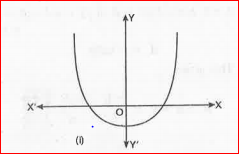Two dice, one blue and one grey are thrown at the same time. Write down all the possible outcomes. : A student argues that 'there are 11 possible outcomes 2, 3, 4, 5, 6, 7, 8, 9, 10, 11 and 12. Therefore, each of them has a probability 111. Do you agree with his argument ? Justify you answer :
 Solution in Punjabi
Solution in Punjabi
Step by step video & image solution for Two dice, one blue and one grey are thrown at the same time. Write down all the possible outcomes. : A student argues that 'there are 11 possible outcomes 2, 3, 4, 5, 6, 7, 8, 9, 10, 11 and 12. Therefore, each of them has a probability 1/11. Do you agree with his argument ? Justify you answer : by Maths experts to help you in doubts & scoring excellent marks in Class 10 exams.
Topper's Solved these Questions
Similar Questions
If a die is thrown, what is the probability that an 'ace' turns up ?
06:04View SolutionThe graphs of y = p (x) are given in figure below, for some polynomials p (x). Find the number of zeroes of p (x), in each case.
 .06:28View Solution
.06:28View SolutionCheck whether the following is quadratic equation :- x=174−1x .
02:11View SolutionRefer to Example 13. (i) Complete the following table (ii) A student argues that 'there are 11 possible outcomes 2,3,4,5,6,7.8,9,10,11 and 12. Therefore, each of them has a probability 111. Do you agree with this argument? Justify
05:41View SolutionTwo dice, one blue and one grey, are thrown at the same time. Complete the following table: Event: Sum on two dice, 2, 3, 4, 5, 6, 7, 8, 9, 10, 11, 12 Probability, , , , , , , , , , , From the above table a student argues that there are 11 possible outcomes 2, 3, 4, 5, 6, 7, 8, 9, 10, 11 and 12. Therefore, each of them has a probability 111 . Do you agree with this argument?
02:10View SolutionDetermine the point of symmetry of a regular hexagon.
02:57View SolutionMatch the following Column A to Column B
 02:03View Solution
02:03View SolutionThe inequation represented by the graph given below is :
01:54View SolutionTwo dice are rolled simultaneously and counts are added
A student argues that there are 11 possible outcomes 2,3,4,5,6,7,8,9,10,11 and 12. Therefore, each of them has a probabilty 111. Do you agree with this argument? Justify your answer.02:26View SolutionTwo dice, one blue and one grey, are thrown at the same time. Write down all the possible outcomes. What is the probability that the sum of the two numbers appearing on the top of the dice is
804:39View SolutionTwo dice, one blue and one grey, are thrown at the same time. Write down all the possible outcomes. What is the probability that the sum of the two numbers appearing on the top of the dice is
1310:34View SolutionTwo dice, one blue and one grey, are thrown at the same time. Write down all the possible outcomes. What is the probability that the sum of the two numbers appearing on the top of the dice is
less than or equal to 1208:41View SolutionTwo dice are rolled simultaneously and counts are added (i) complete the table given
(ii) A student that 'there are 11 possible outcomes 2, 3, 4, 5, 6, 7, 8, 9, 10, 11 and 12. Therefor, each of the them has a probability 111. Do you agree with this argument? Justify your answer.
 02:50View Solution
02:50View SolutionTwo dice, one blue and one grey, are thrown at the same time.
i] Write down all the possible outcomes and complete the following table:

ii] A student argues that 'there are 11 possible outcomes 2,3,4,5,6,7,8,9,10,11 and 12. There, each of them has a probability 111. do you agree with this arguement ?01:32View SolutionTwo dice,one blue and one grey, are thrown at the same time. Complete the following table: Event: Sum on two dice, 2, 3, 4, 5, 6, 7, 8, 9,10, 11, 12 Probability_,_ ,_ ,_ ,_ ,_ ,_ ,_ , ,_ ,_ ,_ From the above table a student argues that there are 11 possible outcomes 2, 3, 4, 5, 6, 7, 8, 9, 10, 11 and 12. Therefore, each of them has a probability 1/11. Do you agree with this argument?
06:03View Solution

